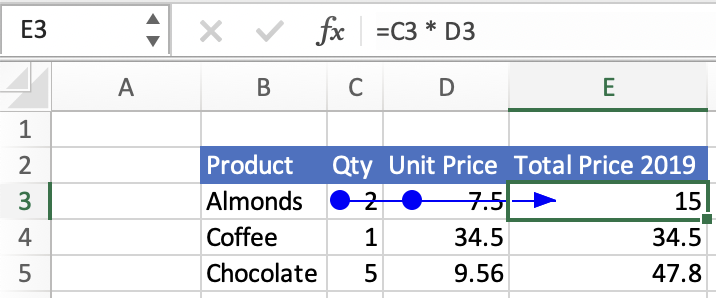Excel 公式通常引用其他单元格。 这些输入单元格是公式的“先例”。 依赖于其他单元格的任何公式单元格都是这些单元格的“依赖”。 若要了解有关相关 Excel UI 功能的详细信息,请参阅 显示公式和单元格之间的关系。
可以形成先例和从属关系链。 先例本身可以有先例,等等。 同样的想法也适用于依赖项。 “直接引用”或“直接依赖”只是第一个级别:公式指向的单元格,或直接指向公式的单元格。
本文提供了使用 Excel JavaScript API 检索公式的先例和依赖项的代码示例。 有关对象支持的属性和方法 Range 的完整列表,请参阅 Range Object (JavaScript API for Excel) 。
要点
- 使用
getPrecedents或getDependents获取所有相关单元格。 使用getDirectPrecedents或getDirectDependents仅获取第一个级别。 - 这两个 API 都返回 一个
WorkbookRangeAreas对象。 它按工作表对地址进行分组。 在每个areas.items列表中查找各个Range对象。 - 非常大的集(例如数千个单元格)可能会很慢。 从直接方法开始,或先缩小选择范围。
- 这些 API 不会跨越工作簿边界。
- 如果没有相关的单元格,
ItemNotFound则会引发错误。 捕获它并显示友好的消息。 - 如果突出显示单元格,请为用户提供清除格式的方法。
获取公式的先例
使用 Range.getPrecedents 查找公式的前置单元格。
Range.getPrecedents 返回 对象 WorkbookRangeAreas 。 此对象包含工作簿中所有先例的地址。 它为每个工作表提供一个单独的 RangeAreas 对象,其中包含至少一个公式前例。 若要了解有关对象的详细信息 RangeAreas ,请参阅 在 Excel 外接程序中同时处理多个区域。
若要仅查找公式的直接单元格,请使用 Range.getDirectPrecedents。
Range.getDirectPrecedents 工作方式类似于 Range.getPrecedents ,并返回一个 WorkbookRangeAreas 对象,其中包含直接先例的地址。
以下屏幕截图显示了在 Excel UI 中选择 “跟踪先例 ”按钮的结果。 此按钮将箭头从前置单元格绘制到所选单元格。 所选单元格 E3 包含公式“=C3 * D3”,因此 C3 和 D3 都是前置单元格。 与 Excel UI 按钮不同, getPrecedents 和 getDirectPrecedents 方法不绘制箭头。

重要
getPrecedents和 getDirectPrecedents 方法不会跨工作簿检索前置单元格。
以下代码示例演示如何使用 Range.getPrecedents 和 Range.getDirectPrecedents 方法。 该示例获取活动区域的前例,然后更改这些单元格的背景色。 直接单元格的背景色设置为黄色,其他前置单元格的背景色设置为橙色。
// This code sample shows how to find and highlight the precedents
// and direct precedents of the currently selected cell.
await Excel.run(async (context) => {
let range = context.workbook.getActiveCell();
// Precedents are all cells that provide data to the selected formula.
let precedents = range.getPrecedents();
// Direct precedents are the parent cells, or the first preceding group of cells that provide data to the selected formula.
let directPrecedents = range.getDirectPrecedents();
range.load("address");
precedents.areas.load("address");
directPrecedents.areas.load("address");
await context.sync();
console.log(`All precedent cells of ${range.address}:`);
// Use the precedents API to loop through all precedents of the active cell.
for (let i = 0; i < precedents.areas.items.length; i++) {
// Highlight and print out the address of all precedent cells.
precedents.areas.items[i].format.fill.color = "Orange";
console.log(` ${precedents.areas.items[i].address}`);
}
console.log(`Direct precedent cells of ${range.address}:`);
// Use the direct precedents API to loop through direct precedents of the active cell.
for (let i = 0; i < directPrecedents.areas.items.length; i++) {
// Highlight and print out the address of each direct precedent cell.
directPrecedents.areas.items[i].format.fill.color = "Yellow";
console.log(` ${directPrecedents.areas.items[i].address}`);
}
});
注意
Range.getPrecedents如果未找到任何单元格,和 Range.getDirectPrecedents 方法将返回ItemNotFound错误。 捕获此内容并提供用户友好的消息。
获取公式的依赖项
使用 Range.getDependents 查找公式的依赖单元格。 与 一样 Range.getPrecedents, Range.getDependents 也返回 对象 WorkbookRangeAreas 。 此对象包含工作簿中所有依赖项的地址。 每个工作表都有一个单独的 RangeAreas 对象,其中包含至少一个依赖于公式的。 有关使用 RangeAreas 对象的详细信息,请参阅 在 Excel 外接程序中同时处理多个区域。
若要仅查找公式的直接依赖单元格,请使用 Range.getDirectDependents。
Range.getDirectDependents 工作方式类似于 Range.getDependents ,并返回一个 WorkbookRangeAreas 对象,其中包含直接依赖项的地址。
以下屏幕截图显示了在 Excel UI 中选择“ 跟踪依赖项 ”按钮的结果。 此按钮将箭头从所选单元格绘制到依赖单元格。 所选单元格 D3 将单元格 E3 作为从属单元格。
E3 包含公式“=C3 * D3”。 与 Excel UI 按钮不同, getDependents 和 getDirectDependents 方法不绘制箭头。

重要
getDependents和 getDirectDependents 方法不会跨工作簿检索依赖单元格。
以下代码示例演示如何使用 Range.getDependents 和 Range.getDirectDependents 方法。 该示例获取活动区域的依赖项,然后更改这些依赖单元格的背景色。 直接依赖单元格的背景色设置为黄色,其他依赖单元格的背景色设置为橙色。
// This code sample shows how to find and highlight the dependents
// and direct dependents of the currently selected cell.
await Excel.run(async (context) => {
let range = context.workbook.getActiveCell();
// Dependents are all cells that contain formulas that refer to other cells.
let dependents = range.getDependents();
// Direct dependents are the child cells, or the first succeeding group of cells in a sequence of cells that refer to other cells.
let directDependents = range.getDirectDependents();
range.load("address");
dependents.areas.load("address");
directDependents.areas.load("address");
await context.sync();
console.log(`All dependent cells of ${range.address}:`);
// Use the dependents API to loop through all dependents of the active cell.
for (let i = 0; i < dependents.areas.items.length; i++) {
// Highlight and print out the addresses of all dependent cells.
dependents.areas.items[i].format.fill.color = "Orange";
console.log(` ${dependents.areas.items[i].address}`);
}
console.log(`Direct dependent cells of ${range.address}:`);
// Use the direct dependents API to loop through direct dependents of the active cell.
for (let i = 0; i < directDependents.areas.items.length; i++) {
// Highlight and print the address of each dependent cell.
directDependents.areas.items[i].format.fill.color = "Yellow";
console.log(` ${directDependents.areas.items[i].address}`);
}
});
注意
Range.getDependents如果未找到依赖单元格,和 Range.getDirectDependents 方法将返回ItemNotFound错误。 捕获此内容并提供用户友好的消息。